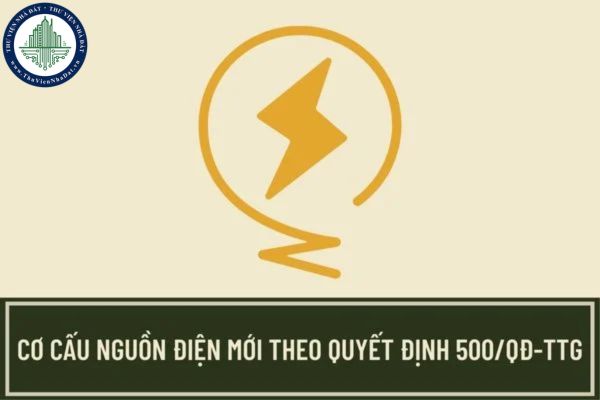Có phải đến năm 2030, sẽ có 02 trung tâm công nghiệp, dịch vụ năng lượng tái tạo liên vùng đúng không?
Nội dung chính
Ưu tiên năng lượng sạch trong cơ cấu nguồn điện mới theo Quyết định 500/QĐ-TTg năm 2023 đúng không?
Ngày 15/5/2023, theo Quyết định 500/QĐ-TTg năm 2023 của Thủ tướng Chính phủ phê duyệt Quy hoạch phát triển điện lực quốc gia thời kỳ 2021 - 2030, tầm nhìn đến năm 2050 (Quy hoạch điện VIII) thì cơ cấu nguồn điện Việt Nam sẽ có nhiều thay đổi theo hướng ưu tiên phát triển năng lượng tái tạo, năng lượng sạch.
Theo đó, đến năm 2030, tổng công suất các nhà máy điện phục vụ nhu cầu trong nước 150.489 MW (không bao gồm xuất khẩu, điện mặt trời mái nhà hiện hữu, năng lượng tái tạo để sản xuất năng lượng mới), trong đó:
- Nguồn điện năng lượng tái tạo gồm: Điện gió trên bờ là 21.880 MW (14,5% tổng công suất các nhà máy điện); điện gió ngoài khơi 6.000 MW (4,0%), trường hợp công nghệ tiến triển nhanh, giá điện và chi phí truyền tải hợp lý thì phát triển quy mô cao hơn.
- Điện mặt trời 12.836 MW (8,5%), không bao gồm điện mặt trời mái nhà hiện hữu, gồm các nguồn điện mặt trời tập trung 10.236 MW, nguồn điện mặt trời tự sản, tự tiêu khoảng 2.600 MW. Nguồn điện mặt trời tự sản, tự tiêu được ưu tiên phát triển không giới hạn công suất.
- Điện sinh khối, điện sản xuất từ rác 2.270 MW (1,5%), trường hợp đủ nguồn nguyên liệu, hiệu quả sử dụng đất cao, có yêu cầu xử lý môi trường, hạ tầng lưới điện cho phép, giá điện và chi phí truyền tải hợp lý thì phát triển quy mô lớn hơn.
- Đối với nguồn thủy điện, đến năm 2030 là 29.346 MW (19,5%) nhưng có thể phát triển cao hơn nếu điều kiện kinh tế - kỹ thuật cho phép; thủy điện tích năng 2.400 MW (1,6%).
- Nguồn nhiệt điện than đạt 30.127 MW (chiếm 20,0%) trừ một số dự án đang triển khai. Tuy nhiên với các nguồn điện than đang gặp khó khăn trong việc triển khai sẽ cập nhật quá trình xử lý để thay thế bằng các nguồn điện LNG hoặc năng lượng tái tạo.
- Nguồn nhiệt điện khí trong nước đạt 14.930 MW (chiếm 9,9%); nhiệt điện LNG là 22.400 MW (chiếm 14,9%); nguồn điện nhập khẩu đạt khoảng 5.000 MW (chiếm 3,3%), nhưng có thể lên đến 8.000 MW.
Ngoài các nguồn điện truyền thống và năng lượng tái tạo, nguồn điện đến năm 2030 sẽ có thêm pin lưu trữ 300 MW (chiếm 0,2%); nguồn điện linh hoạt 300 MW (chiếm 0,2%); nguồn điện đồng phát, sử dụng nhiệt dư, khí lò cao, các sản phẩm phụ của dây chuyền công nghệ trong các cơ sở công nghiệp đạt 2.700 MW (1,8%), quy mô có thể tăng thêm phù hợp với khả năng của các cơ sở công nghiệp.

Có phải đến năm 2030, sẽ có 02 trung tâm công nghiệp, dịch vụ năng lượng tái tạo liên vùng đúng không?
Mục tiêu đến năm 2050 bỏ hẳn nhiệt điện than phải không?
Theo Quyết định 500/QĐ-TTg năm 2023, cơ cấu nguồn điện Việt Nam sẽ có nhiều thay đổi theo hướng giảm và bỏ hẳn nhiệt điện than.
Cụ thể, tổng công suất các nhà máy điện đến năm 2050 đạt từ 490.529-573.129 MW (không bao gồm xuất khẩu, năng lượng tái tạo để sản xuất năng lượng mới).
Trong đó, Thủ tướng quyết định tiếp tục phát triển mạnh nguồn điện năng lượng tái tạo như: Điện gió trên bờ đạt 60.050-77.050 MW (chiếm 12,2-13,4%); điện gió ngoài khơi 70.000-91.500 MW (chiếm 14,3-16%); điện mặt trời đạt từ 168.594-189.294 MW (chiếm 33,0-34,4%); điện sinh khối, điện sản xuất từ rác 6.015 MW (chiếm 1-1,2%).
Nguồn thuỷ điện đến 2050 được phát triển đạt 36.016 MW (chiếm 6,3-7,3%); nguồn điện lưu trữ đạt từ 30.650-45.550 MW (chiếm 6,2-7,9%); điện đồng phát, sử dụng nhiệt dư, khí lò cao, các sản phẩm phụ của dây chuyền công nghệ trong các cơ sở công nghiệp 4.500 MW (chiếm 0,8-0,9%).
Đặc biệt, Quyết định 500/QĐ-TTg năm 2023 nêu rõ sẽ không còn nhiệt điện than (không sử dụng than để phát điện) thay vào đó sẽ phát triển nhiệt điện sử dụng sinh khối và amoniac từ 25.632-32.432 MW (chiếm 4,5-6,6%).
Nguồn nhiệt điện khí bao gồm: Nhiệt điện khí trong nước và chuyển sử dụng LNG là 7.900 MW (chiếm 1,4-1,6%); nhiệt điện khí trong nước chuyển chạy hoàn toàn bằng hydro là 7.030 MW (chiếm 1,2-1,4%); nhiệt điện LNG đốt kèm hydro đạt từ 4.500-9.000 MW (0,8-1,8%); nhiệt điện LNG chuyển chạy hoàn toàn bằng hydro đạt từ 16.400-20.900 MW (3,3-3,6%).
Nguồn điện nhập khẩu đạt khoảng 11.042 MW (1,9-2,3%) và phát triển nguồn điện linh hoạt đạt từ 30.900-46.200 MW (6,3-8,1%).
Dự kiến đến năm 2030, hình thành 02 trung tâm công nghiệp, dịch vụ năng lượng tái tạo liên vùng đúng không?
Tại Quyết định 500/QĐ-TTg năm 2023 có đề cập đến mục tiêu về phát triển hệ sinh thái công nghiệp và dịch vụ năng lượng tái tạo, trong đó có nội dung sau:
- Dự kiến đến 2030, hình thành 02 trung tâm công nghiệp, dịch vụ năng lượng tái tạo liên vùng bao gồm sản xuất, truyền tải và tiêu thụ điện; công nghiệp chế tạo thiết bị năng lượng tái tạo, xây dựng, lắp đặt, dịch vụ liên quan, xây dựng hệ sinh thái công nghiệp năng lượng tái tạo tại các khu vực có nhiều tiềm năng như Bắc Bộ, Nam Trung Bộ, Nam Bộ khi có các điều kiện thuận lợi.
- Phát triển các nguồn điện từ năng lượng tái tạo và sản xuất năng lượng mới phục vụ xuất khẩu.
- Phấn đấu đến năm 2030, quy mô công suất xuất khẩu điện đạt khoảng 5.000 - 10.000 MW.














